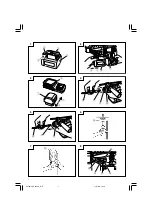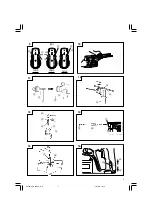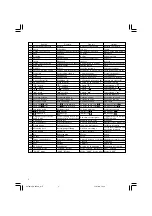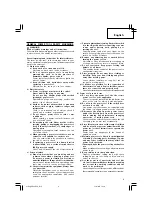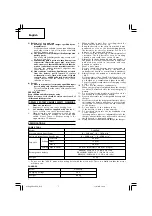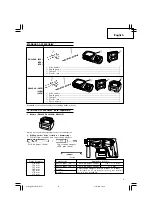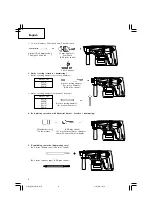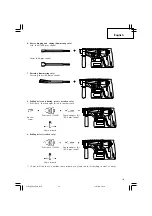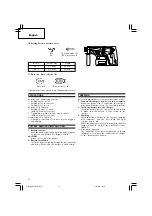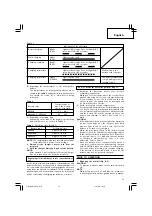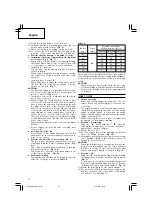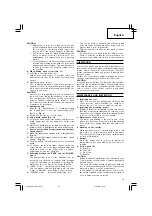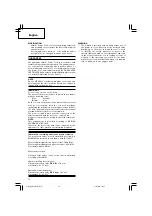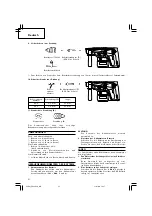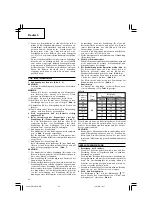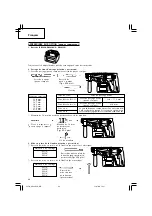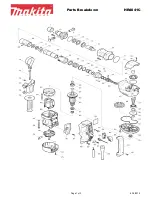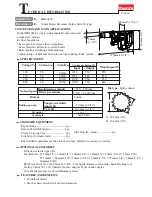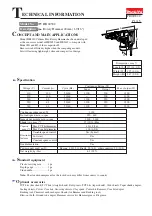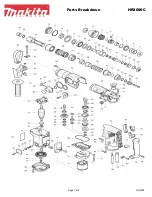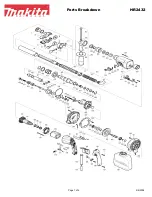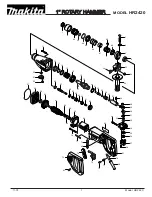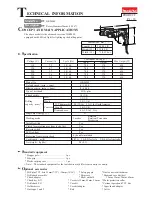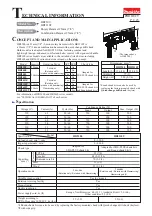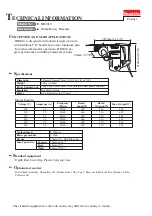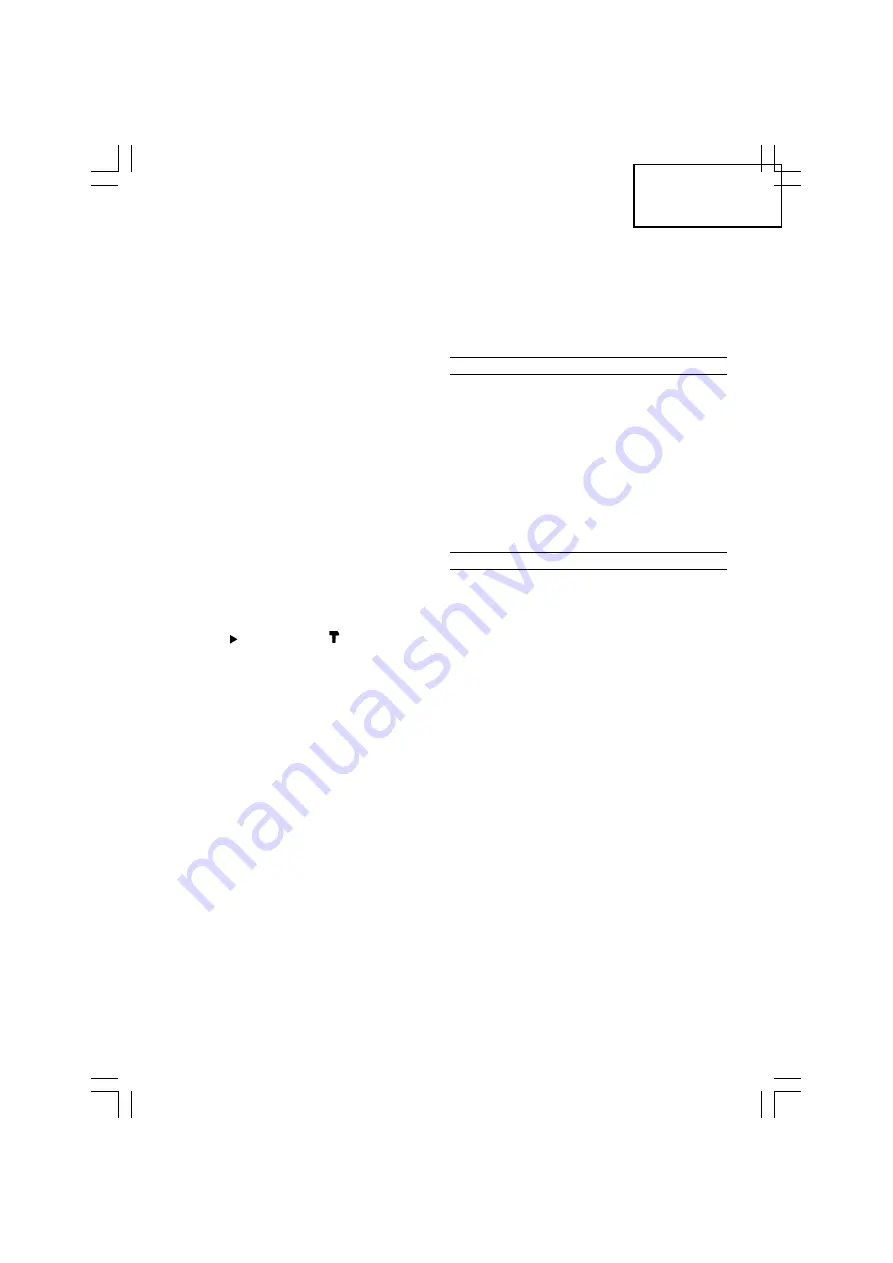
14
English
CAUTION:
䡬
Application of force more than necessary will
not only expedite work at all, but will deteriorate
the tip edge of the drill bit and reduce the
service life of the rotary hammer in addition.
䡬
Drill bit may snap off while withdrawing the
rotary hammer from the drilled hole. For
withdrawing, it is important to use a pushing
motion.
䡬
Do not attempt to use the rotary hammer in the
rotation and striking mode with the drill chuck
and chuck adapter attached. This would seriously
shorten the service life of every component of
the machine.
4. When driving wood screws (Fig. 13)
(1) Selecting a suitable driver bit
Employ plus-head screws, if possible, since the
driver bit easily slips off the heads of slotted-head
screws.
(2) Tightening wood screws
Prior to tightening wood screws, make pilot holes
suitable for them in the wooden board. Apply the
bit to the screw head grooves and gently drive the
screws in the holes.
CAUTION:
Exercise care in preparing a pilot hole suitable for
the wood screw taking the hardness of the wood
into consideration. Should the hole be excessively
small or shallow, requiring much power to drive
the screw into it, the thread of the wood screw may
sometimes be damaged.
5. Hammering only
Align the “
” mark with the “
” mark by rotating
the change lever to set the “Hammering only”
function. (
Fig
.
8
)
(1) Mount the bull point or cold chisel.
6. Using depth gauge (Fig. 12)
(1) Loosen the knob on the side handle, and insert the
depth gauge into the mounting hole on the side
handle.
(2) Adjust the depth gauge position according to the
depth of the hole and tighten the knob bolt securely.
7. How to use the drill bit (taper shank) and the taper
shank adapter
(1) Mount the taper shank adapter to the rotary hammer.
(
Fig. 14
)
(2) Mount the drill bit (taper shank) to the taper shank
adapter. (
Fig. 14
)
(3) Turn the switch ON, and drill a hole to prescribed
depth.
(4) To remove the drill bit (taper shank), insert the
cotter into the slot of the taper shank adapter and
strike the head of the cotter with a hammer
supporting on the rest. (
Fig. 15
)
8. Switching between the “SAVE“ and the “POWER“
modes
The hammering force of the hammer can be
increased or decreased to conform with intended
usage, by operating the shift knob as per
Fig. 16
.
Adjust the force to match the usage intended.
(1) “SAVE“ mode ... decreased hammering force
This can prevent thin drill bits which are less than
5 mm in diameter, from being bent or broken.
(2) “POWER“ mode ... increased hammering force
䡬
This can be used to speedily and efficiently drill
holes when the drill bits which are being used are
greater than 5 mm in diameter.
䡬
This can be used to drill holes into wood or metal.
CAUTION:
Do not drill holes in wood with the “SAVE“ mode.
There is a likelihood that the motor will burn out
because it can easily lock up due to the low power.
LUBRICATION
Low viscosity grease is applied to this rotary hammer so
that it can be used for a long period without replacing the
grease. Please contact the nearest service center for
grease replacement when any grease is leaking form
loosened screw.
Further use of the rotary hammer despite the grease
shortage causes damage to reduce the service life.
CAUTION:
A specific grease (FG-6A) is used with this machine,
therefore, the normal performance of the machine may
be badly affected by use of different grease. Please be
sure to let one of our service centers to undertake
replacement of the grease.
MAINTENANCE AND INSPECTION
1. Inspecting the tool
Since use of a dull tool will degrade efficiency and
cause possible motor malfunction, sharpen or
replace the tool as soon as abrasion is noted.
2. Inspecting the mounting screws
Regularly inspect all mounting screws and ensure
that they are properly tightened. Should any of the
screws be loose, retighten them immediately. Failure
to do so could result in serious hazard.
3. Maintenance of the motor
The motor unit winding is the very “heart” of the
power tool. Exercise due care to ensure the winding
does not become damaged and/or wet with oil or
water.
4. Cleaning on the outside
When the power tool is stained, wipe with a soft
dry cloth or a cloth moistened with soapy water.
Do not use chloric solvents, gasoline or paint thinner,
as they melt plastics.
5. Storage
Store the power tool in a place in which the
temperature is less than 40°C and out of reach of
children.
6. Service parts list
A: Item No.
B: Code No.
C: No. Used
D: Remarks
CAUTION:
Repair, modification and inspection of Hitachi Power
Tools must be carried out by a Hitachi Authorized
Service Center.
This Parts List will be helpful if presented with the
tool to the Hitachi Authorized Service Center when
requesting repair or other maintenance.
In the operation and maintenance of power tools,
the safety regulations and standards prescribed in
each country must be observed.
01Eng_DH24DVA_WE
11/27/08, 13:36
14


